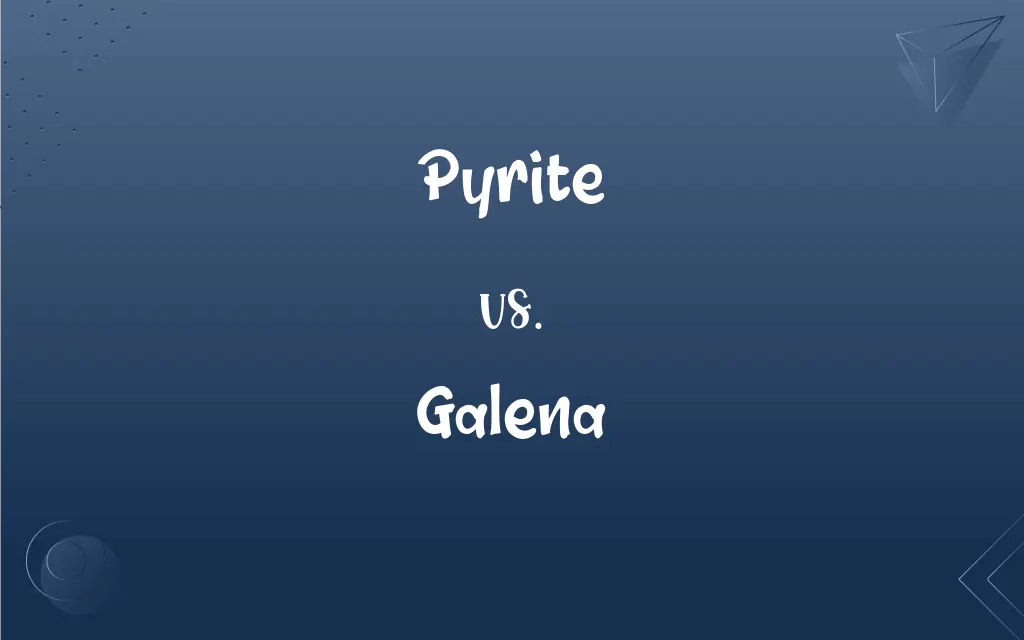Pyrite vs. Galena: What's the Difference?
Edited by Aimie Carlson || By Harlon Moss || Published on February 19, 2024
Pyrite is a natural mineral composed of iron sulfide, known for its metallic luster and gold-like appearance. Galena is a lead sulfide mineral, known for its high density, metallic luster, and silver-gray color.

Key Differences
Pyrite, also known as fool's gold, is an iron sulfide with a distinct gold color and metallic luster, often forming in cubic or octahedral shapes. Galena, on the other hand, is a lead sulfide mineral, characterized by its silver-gray color, high density, and often cube-like crystals.
Historically, pyrite was used in early fire-making techniques due to its ability to spark when struck. It's also mined for its sulfur content. Galena is the most important source of lead and has been used for thousands of years in lead production.
Pyrite forms in an isometric crystal system, with a hardness of 6-6.5 on the Mohs scale, making it quite hard. Galena crystallizes in a cubic system but is softer, with a Mohs hardness of 2.5, making it easily scratched.
Pyrite is often found in sedimentary and metamorphic rocks, and in hydrothermal veins. Galena is commonly associated with limestone and other sedimentary rocks and often occurs with minerals like sphalerite and fluorite.
Pyrite is used in jewelry and as an ore of sulfur for sulfuric acid production. Galena is mainly used for extracting lead, which is used in batteries, radiation shielding, and in the past, in lead-based paints.
ADVERTISEMENT
Comparison Chart
Chemical Formula
Iron Sulfide (FeS2)
Lead Sulfide (PbS)
Color
Gold-like, metallic luster
Silver-gray, metallic luster
Hardness (Mohs)
6-6.5
2.5
Crystal System
Isometric
Cubic
Primary Use
Jewelry, sulfur source
Lead extraction
ADVERTISEMENT
Pyrite and Galena Definitions
Pyrite
Commonly known as fool's gold.
She collected pyrite, or fool's gold, as a hobby.
Galena
Has a high density and cubic crystal structure.
The weighty galena crystal clearly illustrated its high density.
Pyrite
A source of iron and sulfur.
The extraction of sulfur from pyrite is essential for industrial processes.
Galena
Often found in hydrothermal veins.
They discovered galena in the hydrothermal veins during the mining expedition.
Pyrite
Forms in various shapes, including cubes and octahedrons.
The geologist admired the perfect cubic shape of the pyrite crystal.
Galena
Characterized by its silver-gray color and metallic luster.
The galena sample had a distinctive silver-gray sheen.
Pyrite
A brass-yellow mineral with a bright metallic luster.
The miner mistook the pyrite for gold due to its striking resemblance.
Galena
A natural mineral form of lead sulfide.
Galena is the primary ore from which lead is extracted.
Pyrite
Found in sedimentary, metamorphic, and igneous rocks.
Pyrite was discovered in the metamorphic rock at the excavation site.
Galena
Used historically for lead production.
Galena has been mined for centuries for its lead content.
Pyrite
A brass-colored mineral, FeS2, occurring widely and used as an iron ore and in producing sulfur dioxide for sulfuric acid. Also called fool's gold, iron pyrites.
Galena
A gray mineral, essentially PbS, the principal ore of lead.
Pyrite
(mineral) The common mineral iron disulfide (FeS2), of a pale brass-yellow color and brilliant metallic luster, crystallizing in the isometric system.
Galena
(mineral) A mineral, lead sulphide (PbS), mined as an ore for lead.
Pyrite
(usually as a plural: pyrites) Any metallic-looking sulphide, such as the above, which is the most common.
Galena
A remedy or antidote for poison; theriac
Pyrite
(usually as a plural: pyrites) Any metal dichalcogenide that is isostructural to the common mineral.
Copper diselenide can occur both as a marcasite and a pyrite.
Galena
A remedy or antidote for poison; theriaca.
Pyrite
A common mineral of a pale brass-yellow color and brilliant metallic luster, crystallizing in the isometric system; iron pyrites; iron disulphide.
Hence sable coal his massy couch extends,And stars of gold the sparkling pyrite blends.
Galena
Lead sulphide; the principal ore of lead. It is of a bluish gray color and metallic luster, and is cubic in crystallization and cleavage.
Pyrite
A common mineral (iron disulfide) that has a pale yellow color
Galena
Soft blue-gray mineral; lead sulfide; a major source of lead
FAQs
Where is pyrite commonly found?
In various rock types, including sedimentary and metamorphic.
What is pyrite?
A metallic-looking mineral composed of iron sulfide, often mistaken for gold.
How is galena identified?
By its silver-gray color, high density, and cubic crystals.
Are there health risks associated with galena?
Yes, due to its lead content.
What is the primary use of galena?
As the main ore for extracting lead.
Is pyrite magnetic?
No, pyrite is not magnetic.
Can galena be used in jewelry?
Yes, but it's less common due to its softness.
Can pyrite form in quartz?
Yes, pyrite can be found in quartz veins.
How is galena extracted from its ore?
Through a process of crushing, grinding, and flotation.
What distinguishes pyrite from gold?
Pyrite is harder and has a different crystal structure.
Is pyrite used in any industrial processes?
Yes, for sulfur extraction and in jewelry.
Is pyrite visible in gold panning activities?
Yes, it's often mistaken for gold by prospectors.
Can pyrite be synthetically produced?
Yes, for industrial purposes.
What historical significance does galena have?
It was used in ancient times for kohl and pottery glazes.
How was galena used historically?
Primarily for lead production, including in ancient Rome.
Does galena have any role in modern technology?
Its lead is used in batteries and shielding.
Is pyrite found in coal mines?
Yes, it's often found in coal seams.
What happens when pyrite is exposed to air and water?
It can form sulfuric acid.
Does galena have any gemstone uses?
Rarely, due to its softness and lead content.
What are the environmental concerns with galena mining?
Lead pollution and habitat disruption.
About Author
Written by
Harlon MossHarlon is a seasoned quality moderator and accomplished content writer for Difference Wiki. An alumnus of the prestigious University of California, he earned his degree in Computer Science. Leveraging his academic background, Harlon brings a meticulous and informed perspective to his work, ensuring content accuracy and excellence.
Edited by
Aimie CarlsonAimie Carlson, holding a master's degree in English literature, is a fervent English language enthusiast. She lends her writing talents to Difference Wiki, a prominent website that specializes in comparisons, offering readers insightful analyses that both captivate and inform.
































































